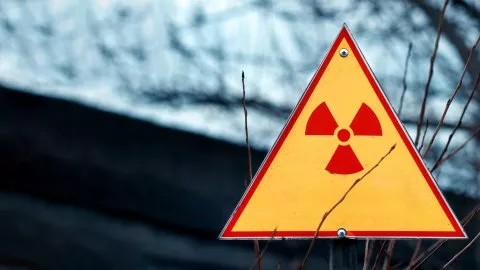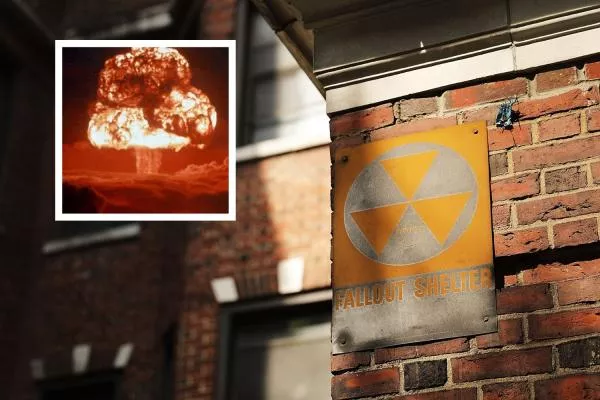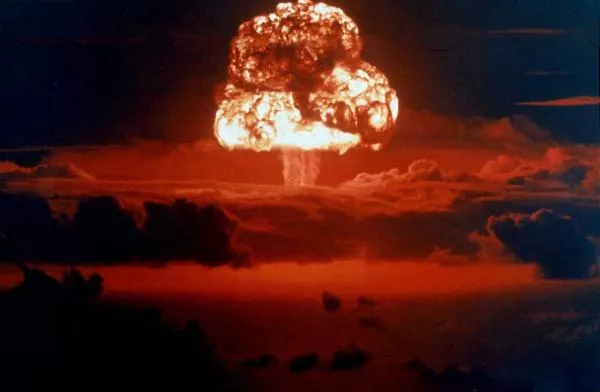ON 10/21/22 AT 12:35 PM EDT
Amid heightened nuclear tensions as the Russia-Ukraine war continues to rage on, many have questioned the chances of a nuclear war and the best and worst places to be located if one were to break out.

U.S. President Joe Biden recently warned that Russian President Vladimir Putin "is not joking" when discussing the possible use of nuclear weapons. "I don't think there's any such thing as the ability to easily use tactical nuclear weapons and not end up with Armageddon," Biden said this month.
In September, Putin warned other nations that Russia will "use all defense methods at our disposal" if the country felt threatened, adding "this is not a bluff." One of Putin's allies, Chechen leader Ramzan Kadyrov, also recently suggested the use of a "low-yield nuclear weapon" in connection to the conflict in Ukraine.
According to data from the Federation of American Scientists, Russia currently owns the most nuclear warheads in the world, with 5,977, while the U.S. has 5,428. The Federation of American Scientists also said that "of the world's 12,700 nuclear warheads, more than 9,400 are in the military stockpiles for use by missiles, aircraft, ships and submarines."
Newsweek recently spoke with experts about some of the worst places to be located if a nuclear war were to break out in the U.S.

In this inset image, a nuclear test is pictured in 1957 next to a leftover fallout shelter sign, one of hundreds in New York, displayed on a building on August 11, 2017, in New York City. Surviving a nuclear attack depends on numerous factors, such as where you are located when a bomb is used, preparedness and surrounding geography.GALERIE BILDERWELT/GETTY; SPENCER PLATT/GETTY
Potential Targets
While speaking with Newsweek on Thursday, Dinshaw Mistry, a professor of international affairs and Asian studies at the University of Cincinnati, explained that the "worst place to be located is the place most likely for a nuclear strike."
"The worst place would essentially be strategic targets, such as military and missile bases...bases are basically in the proximity of populated centers, whether it's cities or towns," Mistry said. "The worst place is essentially population centers near naval facilities, military bases, strategic air command bases."
However, Mistry noted that a "major population center" in the U.S., such as New York City or California, "may actually not be the target of nuclear strike."
Kathryn A. Higley, an Oregon State University professor in the School of Nuclear Science, told Newsweek that some other potential targets could be infrastructure such as power plants or fuel storage centers.
Worst Places to Be
Mark R. StJ. Foreman, an associate professor at Chalmers University of Technology in Göteborg, Sweden, made similar comments while discussing some of the worst possible places to be located if a nuclear bomb was sent to the U.S.
"I would argue that the best place to be during a nuclear attack is in a place where you are not affected by direct effects such as heat and blast and you also have very little fallout radioactivity deposited on your land," Foreman told Newsweek. "If you were outside in an exposed place near a large nuclear detonation then it would be over in a few seconds—you would be likely to be heated by the infrared light from the bomb. This would cause serious burns, and within seconds you would be hit by the blast wave, which would be likely to kill you."
Higley also said that the worst place to be located would be "adjacent" to where the device detonates. According to Higley, if you are located at the spot targeted, you are likely dead very quickly and if you are nearby, you may suffer from thermal and radiation effects, prior to death.
Surviving in the Aftermath
Surviving a nuclear attack depends on numerous factors, such as where you are located when a bomb is used, preparedness and surrounding geography.
Foreman said that if you are inside a bunker when a nuclear bomb is used, you are likely to survive, but he noted that "there is the problem of what do you do when you come out from the bunker, there is a good chance that food production and transport will have stopped."
"You might also face a breakdown of law and order," Foreman said. "One bit of comfort is that many people overplay the problem of mutations in plants, animals and humans. It is unlikely that you will see gross changes in living things around you due to radiation."
According to Foreman, if you are located further out from the area where a bomb is detonated, you may not experience strong blast effects, but he noted that in that case, "you might suffer for longer."
"I think that if the bomb goes off close to you then there is nothing which you can do, there it is the problem of 'survival of the luckiest,' but if you are on the edge of the blast and heat zone then there are things which you can do to protect yourself," Foreman said.

Castle Romeo was the code name given to one of thes tests in the Operation Castle series of U.S. thermonuclear tests beginning in March 1954 at Bikini Atoll. Amid the ongoing war between Russia and Ukraine, nuclear tensions have continued to rise.GALERIE BILDERWELT/GETTY IMAGES
Foreman also spoke about the different ways you can try to protect yourself, saying that "different designs of house will give different degrees of protection against radiation—the worst I can think of is a simple wooden house with no basement."
"In some ways, the best dwelling would be about halfway up a tall tower block which has concrete load bearing walls both on the edge of the building and also inside the building," Foreman said. "A subbasement under a concrete building would be a very good place in terms of shielding, but you have to consider the problem of the building falling down and burying you under a pile of rubble."
In regard to different preparedness levels, Mistry said that it is likely that places that are struck by a nuclear bomb "would have to be both evacuated and, very much like COVID, quarantined."
"Survivors would definitely have to be evacuated but not evacuated back to another population center," Mistry said. "It would almost be like a quarantine."
Additionally, Mistry spoke about the different weather and geographical aspects that could help or hurt the chances of surviving.
"If you are in New York City and a strike is definitely several hundred miles away, you can't rule out winds blowing radiation one way or the other, so if you are downstream from the wind...New York City could still be affected."
Mistry continued, "If it's a valley, the mountains could actually keep radiation in rather than let it spread out. If it's a place near a river, the radiation could actually contaminate the water and it could go downstream and make things worse."
No Safe Place
Newsweek previously reported on some of the best places to be located to survive a potential nuclear attack on the U.S.; however, one expert said that there is no safe place.
"There's no safe place, even relatively safe place," Mistry said.
Likelihood of Attack on the U.S.
Despite ongoing concerns about the potential use of nuclear weapons, Heather Williams, the director of the Project on Nuclear Issues and a senior fellow in the International Security Program at the Center for Strategic and International Studies (CSIS), previously spoke to Newsweek and said that the "likelihood" of Putin using a nuclear weapon "is pretty low."
"The cost would be so significant for him, it would not help him win the war in Ukraine— he would most likely lose a lot of his close partners he relies on," Williams said last week.
What Type of Nuclear Weapon Could Be Used
Williams also said that nuclear weapons have changed drastically throughout history. According to Williams, currently, the main concern would be "tactical nuclear weapons," which are far different than the ones previously used by the U.S. in Japan.
"These would be lower yield, shorter range, potentially battlefield-used nuclear weapons," Williams said.
Source
Foreman also spoke about the different ways you can try to protect yourself, saying that "different designs of house will give different degrees of protection against radiation—the worst I can think of is a simple wooden house with no basement."
"In some ways, the best dwelling would be about halfway up a tall tower block which has concrete load bearing walls both on the edge of the building and also inside the building," Foreman said. "A subbasement under a concrete building would be a very good place in terms of shielding, but you have to consider the problem of the building falling down and burying you under a pile of rubble."
In regard to different preparedness levels, Mistry said that it is likely that places that are struck by a nuclear bomb "would have to be both evacuated and, very much like COVID, quarantined."
"Survivors would definitely have to be evacuated but not evacuated back to another population center," Mistry said. "It would almost be like a quarantine."
Additionally, Mistry spoke about the different weather and geographical aspects that could help or hurt the chances of surviving.
"If you are in New York City and a strike is definitely several hundred miles away, you can't rule out winds blowing radiation one way or the other, so if you are downstream from the wind...New York City could still be affected."
Mistry continued, "If it's a valley, the mountains could actually keep radiation in rather than let it spread out. If it's a place near a river, the radiation could actually contaminate the water and it could go downstream and make things worse."
No Safe Place
Newsweek previously reported on some of the best places to be located to survive a potential nuclear attack on the U.S.; however, one expert said that there is no safe place.
"There's no safe place, even relatively safe place," Mistry said.
Likelihood of Attack on the U.S.
Despite ongoing concerns about the potential use of nuclear weapons, Heather Williams, the director of the Project on Nuclear Issues and a senior fellow in the International Security Program at the Center for Strategic and International Studies (CSIS), previously spoke to Newsweek and said that the "likelihood" of Putin using a nuclear weapon "is pretty low."
"The cost would be so significant for him, it would not help him win the war in Ukraine— he would most likely lose a lot of his close partners he relies on," Williams said last week.
What Type of Nuclear Weapon Could Be Used
Williams also said that nuclear weapons have changed drastically throughout history. According to Williams, currently, the main concern would be "tactical nuclear weapons," which are far different than the ones previously used by the U.S. in Japan.
"These would be lower yield, shorter range, potentially battlefield-used nuclear weapons," Williams said.
Source
No comments:
Post a Comment